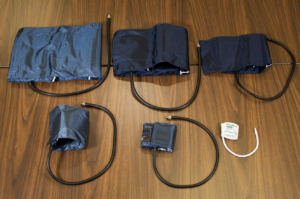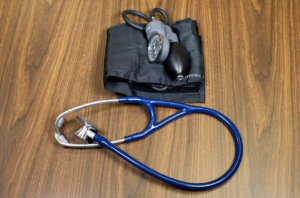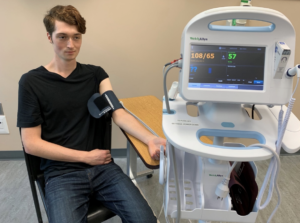What is Blood Pressure?
Blood pressure is the force of blood exerted against the arterial walls, and is reported in millimetres of mercury (mm Hg). Try turning your kitchen tap on just a little bit, and then full blast. Compare the varying forces of water pressure as you adjust the tap. This comparison will give you a better sense of blood pressure.
The pressure against the arterial walls (the blood pressure) changes depending on whether the heart is contracting and pushing blood out into the arteries or whether the heart is in a resting phase and filling with blood. There is always force against the arterial walls, even when the heart is in a resting phase. The systolic pressure is the maximum pressure on the arteries during left ventricular contraction (systole) . The left ventricle is a lower chamber of the heart responsible for pumping blood out to the body. The diastolic pressure is the resting pressure on the arteries between each cardiac contraction when the heart’s chambers are filling with blood (diastole).
Stroke volume is the amount of blood ejected from the left ventricle in a single contraction. Stroke volume provides information about the functioning of the heart. Stroke volume is influenced by age and typically ranges from 5–80 mL. Newborns have a stroke volume of about 5 mL per contraction while adults have a stroke volume of about 30–70 mL per contraction; the stroke volume increases as individuals grow and their hearts become stronger and can pump more volume per contraction. Direct measurement of stroke volume involves an invasive approach in which a catheter is passed into the pulmonary artery via a large neck vein; this monitoring device is only used during critical care situations.
Indirect measurement of stroke volume involves assessing the pulse pressure, which is the difference between the systolic and diastolic values and signifies the force required by the heart each time it contracts. For example, if someone’s blood pressure is 120/80 mm Hg, the pulse pressure is 40 mm Hg. A higher pulse pressure can indicate arterial stiffness, which often happens as a result of aging or cardiovascular disease. A higher pulse pressure can also be indicative of aortic valvular insufficiency where the diastolic pressure is unusually low and the systolic pressure is mildly elevated or unchanged. A lower pulse pressure can be a marker of poor heart function, where cardiac output is decreased.
Why is Blood Pressure Measured?
- A person’s blood pressure provides insight into the functioning of the body
- Healthy body functioning is influenced by healthy blood pressure
- The findings can provide information about the integrity of arteries and heart functioning, which can lead the LPN/RN to conduct additional assessments
- High blood pressure can cause the arteries to become weak and damaged and cause the heart to become weak and enlarged
- Low blood pressure can decrease perfusion of nutrients and oxygen to the body’s cells, influencing ability to function and potentially cellular death
- Chronic high blood pressure can contribute to conditions such as vascular disease, myocardial infarction, cerebral stroke, kidney disease, and dementia.
What are Blood Pressure Ranges?
Blood pressure is reported in mm Hg (pronounced millimetres of mercury), in which the systolic is the numerator and diastolic is the denominator. See Table 9.10.1 for an overview of estimated blood pressure ranges for healthy individuals.
Table 9.10.1: Estimated Blood Pressure Ranges (mm Hg)
|
Age |
Systolic Range |
Diastolic Range |
| Newborn to 6 months | 45–90 | 30–65 |
| 6 months to 2 years | 80–100 | 40–70 |
| Children (2–13 years) | 80–120 | 40–80 |
| Adolescent (14–18 years) | 90–120 | 50–80 |
| Adult (19–40 years) | 95–135 | 60–80 |
| Adult (41–60 years) | 110–145 | 70–90 |
| Older adult (61 years and older) | 95–145 | 70–90 |
Points to Consider
The average blood pressure for an adult is sometimes noted as 120/80 mm Hg. However, this is only an average and the LPN/RN or physician needs to consider acceptable ranges for individual clients. For example, in adults, normal blood pressure can range from 95–145/60–90 mm Hg. The client’s baseline blood pressure and the client’s current health state in conjunction with subjective data and other objective data will be considered. For example, a blood pressure of 90/50 mm Hg may be normal for a healthy, asymptomatic 20-year-old adult.
Factors that influence blood pressure include age, sex, ethnicity, weight, exercise, emotions/stress, pregnancy, and diurnal rhythm as well as medication use and disease processes.
- The general pattern is that blood pressure rises with age, so normal variations tend to be higher for older adults.
- Blood pressure is similar in childhood for males and females. After puberty, females have lower blood pressure than males, whereas after menopause females have higher blood pressure than males.
- Research has revealed that ethnicity may be a predictor of blood pressure, but this causation is not necessarily biological, but rather sociocultural. When determining risk for high blood pressure, it is important to consider ethnicity as a contributing factor.
- The diurnal cycle influences blood pressure to be lower in the morning and increase throughout the day until early evening. Try it out: take your blood pressure when you wake up in the morning and then again in late afternoon, and note the difference. This is one reason why healthcare providers document the time a client’s blood pressure is taken.
- Blood pressure can be higher in people who are obese because the heart has to work harder to perfuse the body’s tissues.
- The sympathetic nervous system is stimulated by exercise, stress, anxiety, pain, anger, and fear, which increases blood pressure. Blood pressure returns to baseline within five minutes of rest following activity. Try it out. Have a peer take your blood pressure. Then, run on the spot or do some other cardiac activity for five minutes. Have the peer take your blood pressure again, and then lie down and rest for five minutes. Take the blood pressure again. Note the changes.
- Blood pressure varies throughout the duration of pregnancy. It decreases about halfway through the first trimester until mid-pregnancy due to progesterone effects that relax the walls of blood vessels, causing decreased peripheral vascular resistance. It returns to pre-pregnancy values toward the end of pregnancy.
Points to Consider
White coat syndrome refers to elevated blood pressure due to nervousness or anxiety when clients have their blood pressure taken by a healthcare provider. This occurs in approximately 20% of clients. Key message: have the client take their blood pressure at home with an automatic home blood pressure cuff and compare the findings. Alternatively, you can ask the client to sit quietly and leave the room while an automatic cuff takes a client’s blood pressure. The automatic cuff can be programmed to take three measurements and the blood pressure documented is an average of the three readings.
How is Blood Pressure Measured?
Blood pressure is measured in many ways including manual/auscultatory, automatic/electronic, cellular phone applications, and arterial catheters. The Health Care Assistant will utilize an automatic/electronic device, and LPN/RNs may utilize other methods. Whatever method is used, blood pressure must be measured using validated equipment. It has been found that blood pressure is often not measured accurately in clinical practice, particularly when using the auscultatory/manual method. It is important to ensure correct technique to obtain an accurate measurement. Hypertension Canada (2020) recommends electronic blood pressure measurement as the preferred method in clinical practice.
Client Positioning
Blood pressure is generally taken in a sitting or supine position with the bare arm at heart level . Certain health states prevent some clients from sitting, such as clients who are critically ill, unstable, or postoperative. Thus, healthcare providers document the client’s positioning (e.g., sitting, supine, standing). If sitting, the feet are placed flat on the floor with the back resting comfortably against a chair. The healthcare provider checks to ensure that the client’s legs are not crossed, because this can increase blood pressure. The client sits resting for five minutes before you take the blood pressure. This waiting period is not feasible when the client’s condition is deteriorating or a STAT blood pressure is required. Because the client should be resting, you should ask them not to talk or move. Additionally, you should not ask them to hold any of your equipment during the blood pressure measurement.
Cuff Types and Sizes
Manual and automatic blood pressure measurement involves using a blood pressure cuff with a sphygmomanometer. Many cuff sizes are available to fit newborns, children, adults, people with small and larger arms, and people with cone-shaped arms. The cuff is typically wrapped around the upper arm. However, there is also a cuff that can be placed on the thigh when the arm is not feasible. See Figure 9.10.1 of varying blood pressure cuff sizes. Wrist devices can be used for blood pressure estimation when clients have a large upper arm circumference (Nerenberg, 2018). When taking the measurement, make sure that the arm and wrist are supported at heart level (Nerenberg, 2018).

It is important to choose a cuff size that matches the client’s arm size, rather than their age. See Table 9.10.2 about cuff sizing. Measuring the client’s arm and determining cuff size may be the responsibility of LPN/RN.
Table 9.10.2: Cuff Sizing
|
Cuff Sizing |
| The width of the cuff is 40% of the person’s arm circumference |
| The length of the cuff’s bladder is 80–100% of the person’s arm circumference |
Blood Pressure Methods
Measuring blood pressure may be a delegation of task for Health Care Assistants. Ensure you are following your agency’s policy regarding blood pressure monitoring. Manual blood pressure measurement is taken using a blood pressure cuff with a sphygmomanometer and a stethoscope. See Figure 9.10.2.

Automatic blood pressure cuffs are a digital way to measure blood pressure. See Figure 9.10.3. After positioning the client and the blood pressure cuff on the arm, press the start button on the monitor. The cuff is automatically inflated and then deflates at a rate of 2 mm Hg per second. The monitor has a digital display that shows the blood pressure reading when done. Automatic cuffs can be programmed to take a series of blood pressure readings in a row. If the healthcare provider is concerned about an initial high blood pressure reading on a client, the accuracy of the blood pressure is verified with the following actions:
- have the client sit in a room by themselves
- quiet the room
- dim the lights
- allow the client to sit quietly, without talking
- then take three measurements, a few minutes apart, with the automatic cuff. The blood pressure displayed is an average of the three readings.

Clients can monitor their own blood pressure at home with an automatic digital blood pressure monitoring device. Clients are advised to use a device that meets the standards of the Association for the Advancement of Medical Instrumentation, the requirements of the British Hypertension Society protocol, or the International Protocol for Validation of Automated Blood Pressure Measuring Devices. The cuff is applied around the client’s upper arm or wrist. Similar to the automatic cuff noted above, the client presses the start button and the cuff inflates and deflates based on programmed levels displaying a digital reading. Clients are encouraged to document their blood pressure or use a device with data-recording capabilities to increase the reliability of their reported home blood pressure monitoring. These data can be shared with the client’s primary care provider.
Cellular phone applications have been developed to measure blood pressure, but the accuracy of this technology is still being investigated.
Summary:
Blood pressure measurement is important because it provides objective data about the client’s health and illness state. Changes in blood pressure act as a cue for changes in the client’s health. Blood pressure fluctuates with internal and external factors. More than one measurement must be taken before a clinical decision is made by a LPN/RN or physician.
It is always important to ensure correct techniques when taking blood pressure. Taking a blood pressure may be a delegation of task for a Health Care Assistant and they should be aware of agency policies related to blood pressure monitoring.
Examples

